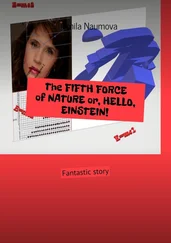Michael Faraday - On the various forces of nature and their relations to each other
Здесь есть возможность читать онлайн «Michael Faraday - On the various forces of nature and their relations to each other» — ознакомительный отрывок электронной книги совершенно бесплатно, а после прочтения отрывка купить полную версию. В некоторых случаях можно слушать аудио, скачать через торрент в формате fb2 и присутствует краткое содержание. Жанр: foreign_antique, foreign_prose, на английском языке. Описание произведения, (предисловие) а так же отзывы посетителей доступны на портале библиотеки ЛибКат.
- Название:On the various forces of nature and their relations to each other
- Автор:
- Жанр:
- Год:неизвестен
- ISBN:нет данных
- Рейтинг книги:3 / 5. Голосов: 1
-
Избранное:Добавить в избранное
- Отзывы:
-
Ваша оценка:
- 60
- 1
- 2
- 3
- 4
- 5
On the various forces of nature and their relations to each other: краткое содержание, описание и аннотация
Предлагаем к чтению аннотацию, описание, краткое содержание или предисловие (зависит от того, что написал сам автор книги «On the various forces of nature and their relations to each other»). Если вы не нашли необходимую информацию о книге — напишите в комментариях, мы постараемся отыскать её.
On the various forces of nature and their relations to each other — читать онлайн ознакомительный отрывок
Ниже представлен текст книги, разбитый по страницам. Система сохранения места последней прочитанной страницы, позволяет с удобством читать онлайн бесплатно книгу «On the various forces of nature and their relations to each other», без необходимости каждый раз заново искать на чём Вы остановились. Поставьте закладку, и сможете в любой момент перейти на страницу, на которой закончили чтение.
Интервал:
Закладка:
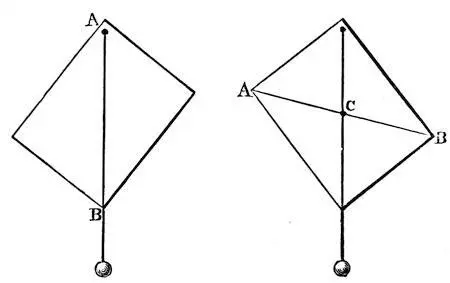
Fig. 3. and Fig. 4.
There is another point I want in the next place to draw your attention to. I have here a quantity of shot; each of these falls separately, and each has its own gravitating power, as you perceive when I let them fall loosely on a sheet of paper. If I put them into a bottle, I collect them together as one mass; and philosophers have discovered that there is a certain point in the middle of the whole collection of shots that may be considered as the one point in which all their gravitating power is centred, and that point they call the centre of gravity : it is not at all a bad name, and rather a short one – the centre of gravity. Now suppose I take a sheet of pasteboard, or any other thing easily dealt with, and run a bradawl through it at one corner A (fig. 3), and Mr. Anderson hold that up in his hand before us, and I then take a piece of thread and an ivory ball, and hang that upon the awl – then the centre of gravity of both the pasteboard and the ball and string are as near as they can get to the centre of the earth; that is to say, the whole of the attracting power of the earth is, as it were, centred in a single point of the cardboard – and this point is exactly below the point of suspension. All I have to do, therefore, is to draw a line, A B, corresponding with the string, and we shall find that the centre of gravity is somewhere in that line. But where? To find that out, all we have to do is to take another place for the awl (fig. 4), hang the plumb-line, and make the same experiment, and there [at the point C] is the centre of gravity – there where the two lines which I have traced cross each other; and if I take that pasteboard, and make a hole with the bradawl through it at that point, you will see that it will be supported in any position in which it may be placed. Now, knowing that, what do I do when I try to stand upon one leg? Do you not see that I push myself over to the left side, and quietly take up the right leg, and thus bring some central point in my body over this left leg. What is that point which I throw over? You will know at once that it is the centre of gravity – that point in me where the whole gravitating force of my body is centred, and which I thus bring in a line over my foot.

Fig. 5. and Fig. 6.
Here is a toy I happened to see the other day, which will, I think, serve to illustrate our subject very well. That toy ought to lie something in this manner (fig. 5); and would do so if it were uniform in substance. But you see it does not; it will get up again. And now philosophy comes to our aid; and I am perfectly sure, without looking inside the figure, that there is some arrangement by which the centre of gravity is at the lowest point when the image is standing upright; and we may be certain, when I am tilting it over (see fig. 6), that I am lifting up the centre of gravity ( a ), and raising it from the earth. All this is effected by putting a piece of lead inside the lower part of the image, and making the base of large curvature; and there you have the whole secret. But what will happen if I try to make the figure stand upon a sharp point? You observe, I must get that point exactly under the centre of gravity, or it will fall over thus [endeavouring unsuccessfully to balance it]; and this you see is a difficult matter – I cannot make it stand steadily. But if I embarrass this poor old lady with a world of trouble, and hang this wire with bullets at each end about her neck, it is very evident that, owing to there being those balls of lead hanging down on either side, in addition to the lead inside, I have lowered the centre of gravity, and now she will stand upon this point (fig. 7); and what is more, she proves the truth of our philosophy by standing sideways.
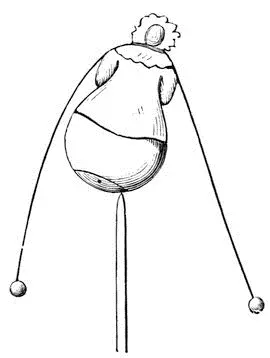
Fig. 7.
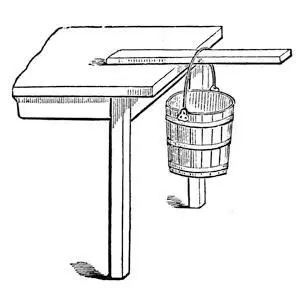
Fig. 8.
I remember an experiment which puzzled me very much when a boy. I read it in a conjuring book, and this was how the problem was put to us: “How,” as the book said, “how to hang a pail of water, by means of a stick, upon the side of a table” (fig. 8). Now, I have here a table, a piece of stick, and a pail, and the proposition is, how can that pail be hung to the edge of this table? It is to be done; and can you at all anticipate what arrangement I shall make to enable me to succeed? Why, this. I take a stick, and put it in the pail between the bottom and the horizontal piece of wood, and thus give it a stiff handle – and there it is; and what is more, the more water I put into the pail the better it will hang. It is very true that before I quite succeeded I had the misfortune to push the bottoms of several pails out; but here it is hanging firmly (fig. 9), and you now see how you can hang up the pail in the way which the conjuring books require.
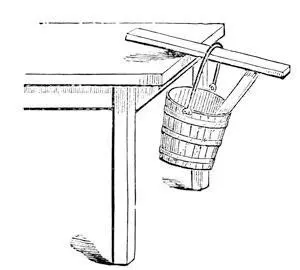
Fig. 9.
Again, if you are really so inclined (and I do hope all of you are), you will find a great deal of philosophy in this [holding up a cork and a pointed thin stick about a foot long]. Do not refer to your toy-books, and say you have seen that before. Answer me rather, if I ask you have you understood it before? It is an experiment which appeared very wonderful to me when I was a boy; I used to take a piece of cork (and I remember, I thought at first that it was very important that it should be cut out in the shape of a man; but by degrees I got rid of that idea), and the problem was to balance it on the point of a stick. Now, you will see I have only to place two sharp-pointed sticks one on each side, and give it wings, thus, and you will find this beautiful condition fulfilled.
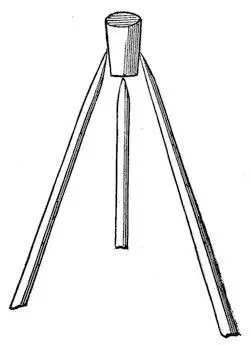
Fig. 10.
We come now to another point: – All bodies, whether heavy or light, fall to the earth by this force which we call gravity. By observation, moreover, we see that bodies do not occupy the same time in falling. I think you will be able to see that this piece of paper and that ivory ball fall with different velocities to the table [dropping them]; and if, again, I take a feather and an ivory ball, and let them fall, you see they reach the table or earth at different times – that is to say, the ball falls faster than the feather. Now, that should not be so, for all bodies do fall equally fast to the earth. There are one or two beautiful points included in that statement. First of all, it is manifest that an ounce, or a pound, or a ton, or a thousand tons, all fall equally fast, no one faster than another: here are two balls of lead, a very light one and a very heavy one, and you perceive they both fall to the earth in the same time. Now, if I were to put into a little bag a number of these balls sufficient to make up a bulk equal to the large one, they would also fall in the same time; for if an avalanche fall from the mountains, the rocks, snow and ice, together falling towards the earth, fall with the same velocity, whatever be their size.
I cannot take a better illustration of this than that of gold leaf, because it brings before us the reason of this apparent difference in the time of the fall. Here is a piece of gold-leaf. Now, if I take a lump of gold and this gold-leaf, and let them fall through the air together, you see that the lump of gold – the sovereign, or coin – will fall much faster than the gold leaf. But why? They are both gold, whether sovereign or gold-leaf. Why should they not fall to the earth with the same quickness? They would do so , but that the air around our globe interferes very much where we have the piece of gold so extended and enlarged as to offer much obstruction on falling through it. I will, however, shew you that gold-leaf does fall as fast when the resistance of the air is excluded – for if I take a piece of gold-leaf and hang it in the centre of a bottle, so that the gold, and the bottle, and the air within shall all have an equal chance of falling, then the gold-leaf will fall as fast as anything else. And if I suspend the bottle containing the gold-leaf to a string, and set it oscillating like a pendulum, I may make it vibrate as hard as I please, and the gold-leaf will not be disturbed, but will swing as steadily as a piece of iron would do; and I might even swing it round my head with any degree of force, and it would remain undisturbed. Or I can try another kind of experiment: – if I raise the gold-leaf in this way [pulling the bottle up to the ceiling of the theatre by means of a cord and pulley, and then suddenly letting it fall to within a few inches of the lecture-table], and allow it then to fall from the ceiling downwards (I will put something beneath to catch it, supposing I should be maladroit ), you will perceive that the gold-leaf is not in the least disturbed. The resistance of the air having been avoided, the glass bottle and gold-leaf all fall exactly in the same time.
Читать дальшеИнтервал:
Закладка:
Похожие книги на «On the various forces of nature and their relations to each other»
Представляем Вашему вниманию похожие книги на «On the various forces of nature and their relations to each other» списком для выбора. Мы отобрали схожую по названию и смыслу литературу в надежде предоставить читателям больше вариантов отыскать новые, интересные, ещё непрочитанные произведения.
Обсуждение, отзывы о книге «On the various forces of nature and their relations to each other» и просто собственные мнения читателей. Оставьте ваши комментарии, напишите, что Вы думаете о произведении, его смысле или главных героях. Укажите что конкретно понравилось, а что нет, и почему Вы так считаете.


